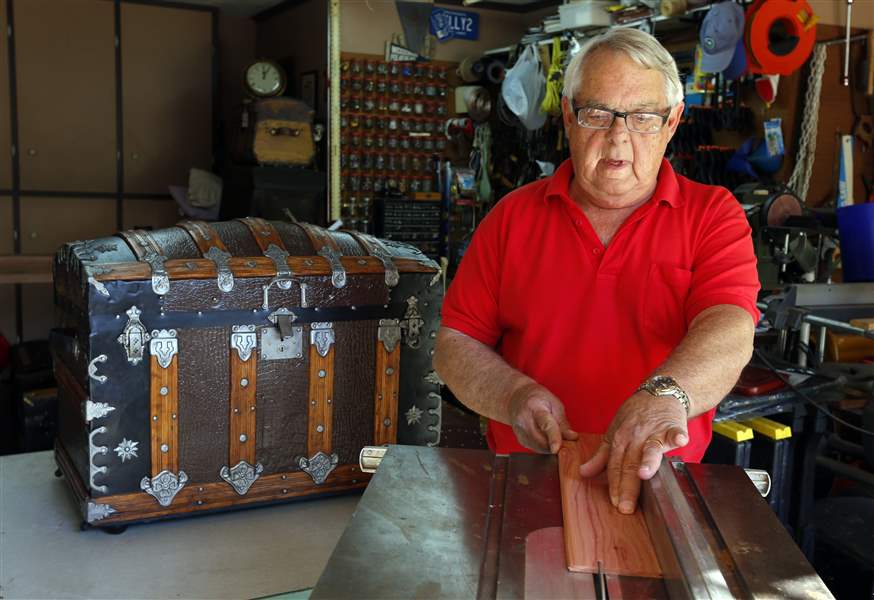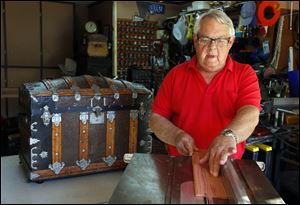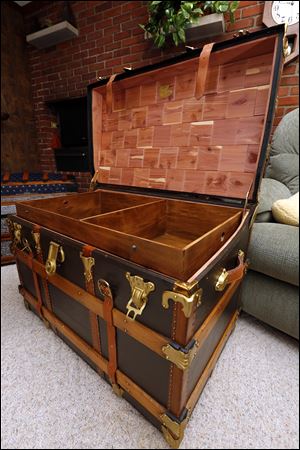
TOLEDO MAGAZINE
Trunk Show: Lambertville man brings old beauties back to life
10/19/2013
Al Obst works on a trunk at his Lambertville home.
The Blade/Andy Morrison
Buy This Image

Al Obst works on a trunk at his Lambertville home.
Before a trunk was known as the rear storage compartment of a car, it was a rectangular box for transporting belongings when taking a trip by wagon, ship, or train, or storing objects in the attic.
Lee Ann Obst, like many teenaged girls in the 1950s and earlier, had a special one: a hope chest filled with items she figured she’d need as a newlywed. But she coveted the trunk her sister had — their great-great-grandmother’s ornate 1880s camelback — so she engineered a swap.
Click here to view related gallery.
Little did she know that 50-some years later, that act would result in her home being filled with 30 antique trunks, the restoration of which became a passion of her husband, Al Obst. They worked together on her ancestral trunk in the 1970s, and then fixed up trunks for both of their children. But his hobby kicked into high gear in 2000 when Mr. Obst met a restorer in Brighton, Mich., and purchased some trunks from him.
“We’ve become real good friends and trunk buddies,” says Mr. Obst of Lambertville. He began keeping an eye out for them at garage sales, antique stores, in newspaper ads, and eventually online, buying the good, the bad, and the ugly for between $4 and $125.

A Toledo-made wall trunk at the Lambertville home of Al Obst.
Most of his date to the 1850s through the early 1900s, and were covered with heavy decorative paper that was torn and foul smelling. After removing it, he sands and stains the exterior wood, lines the interior with strips or squares of cedar, and repairs the tray insert or builds a new one. Stamped tin and brass get cleaned and sometimes painted. He orders new stampings, decorative buttons, hardware, leather straps, and handles as needed.
“I’m not necessarily trying to make it look original,” he says. And he can’t help but wonder, when working on it for up to 100 hours, who owned it, what it held, and where it traveled.
Identifying marks are rare, making it difficult to date them, but he picked up an ingenious model at a Michigan auction for $20 with a label saying it was made in Toledo by John B. Duguid. Called a wall trunk, its lid is hinged, allowing the top to slide in slightly when opened so it can be pushed flush against a wall.
His post-Civil War trunks have wooden handles and just a little a steel, which wouldn’t have been used for embellishment during the war, he says. Half trunks are smaller than the full sized (28 to 36 inches wide, 15 to 20 inches deep, and 20 to 30 inches high).
Saratogas are large and ornate, often splendid with scrolled and fluted hardware and weighing up to 70 pounds. Petite doll trunks may have been used by children to store doll clothes or as a woman’s toiletry case, he says. Several, including a mid-sized Jenny Lind trunk, named for the Swedish soprano of the 1800s, are stacked in his well-equipped workshop.
His jewel is a big, stately gentleman’s trunk, its leather top fortified by five wooden slats. It was locked when he bought it from a family who operated the Mansion View Inn in the Old West End. After he got it home, he was able to open it with a key from another trunk and a screwdriver. Its contents: old magazines, oil-soaked rags, and steel wool.
He has not sold any of the 70 he’s restored but has given dozens away as gifts.
Explaining why he’s charmed by these old beauties, he says: “I guess it’s the fact that they’re a mess, and for some unknown reason I have the talent to bring them back to life.”
He hopes they’ll live for another 100 years.
Contact Tahree Lane at tlane@theblade.com and 419-724-6075.